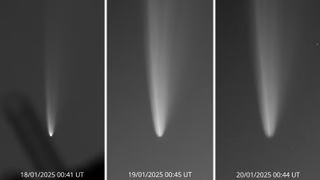The “once-in-a-lifetime” comet that recently lit up night skies for the first time in millennia might be falling apart after being singed as it slingshotted around the sun, new photos suggest. However, it is too early to tell for sure.
Comet C/2024 G3 (ATLAS) made its closest approach to Earth on Jan. 14 and reached its minimum distance from the sun, known as perihelion, a day later. As a result, it shone as bright as Venus for several days and was visible across the globe. It has now begun its long journey back to the Oort Cloud — a reservoir of comets and other icy objects near the edge of the solar system — and is not expected to return for around 160,000 years.
Although the comet has now become too faint for people to see with the naked eye, astrophotographers have continued to snap images of the comet as it journeys back to the outer solar system — and things aren’t looking good for the icy object.
Hungarian astrophotographer Lionel Majzik photographed the comet from the dark skies of Chile over three consecutive nights, between Jan. 18 and Jan. 20. He noticed that the comet’s coma — the cloud around its nucleus — had dimmed significantly during this time, hinting that the comet’s head may have started breaking apart, according to Spaceweather.com.
The photos also showed a bright streak of light, or “streamer,” in the comet’s tail, which is a sign that large amounts of gas and dust are leaking out of the comet, potentially via new cracks in its nucleus.
“Only one week ago, Comet ATLAS passed very close to the sun,” Spaceweather.com reported. “The thermal stress may have been too much.”
Related: ‘Totally amazing’ astronaut photo captures comet C/2024 G3 ATLAS shooting past Earth from the ISS
The latest development is surprising, considering that initial observations of the comet after perihelion suggested it had remained unaffected by its “near-death encounter with the Sun,” Richard Miles, an astronomer and comet expert with the British Astronomical Association, said in a statement. However, it can be “quite difficult to predict how the comet will behave” after such an encounter, he added.
Simulations from Nicolas Lefaudeux, a French engineer and amateur astronomer, suggested that the…
Click Here to Read the Full Original Article at Latest from Livescience…

